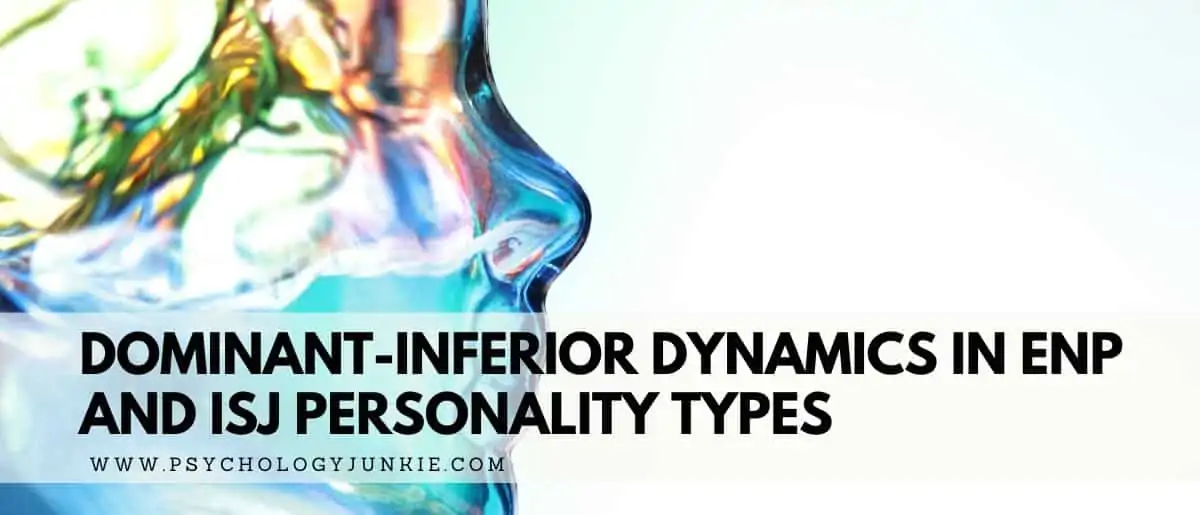Dominant-Inferior Dynamics in ENP and ISJ Personality Types
Today I want to explore the dominant-inferior dynamics of the ENFP, ENTP, ISFJ, and ISTJ personality types. These four types are unique in that they share the same perceiving functions; Extraverted Intuition (Ne) and Introverted Sensation (Si). They are also unique in that one type’s dominant is the other type’s inferior (ENPs have dominant Extraverted Intuition, while ISJs have Inferior Extraverted Intuition and vice versa). Today we’re going to explore, from a metaphorical standpoint, how these functions show up in the personality types, by describing them as siblings. One sibling is the favored older brother, he will represent the dominant function. The other sibling is the obnoxious younger sibling who will represent the inferior function. My goal in describing the functions this way is that it will help you to envision how these functions show up, why you channel them the way you do, and what kind of credence you give them.
Not sure what your personality type is? Take our new personality questionnaire here. Or you can take the official MBTI® here.

Table of contents
Estimated reading time: 10 minutes
ENFP and ENTP Personality Types – Extraverted Intuition and Introverted Sensation (Ne and Si)
If Extraverted Intuition (Ne) is in the dominant position, its perspectives are highly valued and attended to. For ENFPs and ENTPs, priority is always given to the world of Ne. This means possibilities, innovation, and alternatives play before their mind’s eye on a regular basis. A rock isn’t just a rock, it’s a weapon in a slingshot, a piece in a mosaic, a structure in a fairy house in the garden. Everything holds dozens of possibilities, and those possibilities are what inspire the ENxP type. The world of the future and tomorrow is the world that compels the ENxP, calling to them like a siren song, beckoning them to explore what could exist or take place in the future.
Introverted Sensation, in contrast, is akin to the least-favored younger sibling. This function toils in the background, offering up bits and pieces of wisdom which are usually pushed aside by Ne. It’s as if Ne gives a haughty laugh at Si’s thoughts, patting Si condescendingly on the head and telling them to leave this job to “more experienced” people.
A Glimpse At Dominant Extraverted Intuition:
- Generates possibilities for the future
- Sees things from multiple angles
- Seeks novelty
- Explores ways to innovate and change things
- Focuses on the conceptual and abstract
- Experiments with unconventional ideas and approaches
- Is curious and driven by change and transformation
But what does Si bring to the ENxP?
Si is the function that reminds the ENxP about the long-standing inner impressions that the concrete world evokes. Rather than seeing a rock and thinking of mosaics and slingshots and fairy houses, it tells the ENxP to look deeper, not broader. What peculiar shades and textures does the rock have on it? How does the rock remind him of some of his own impressions from the past? What type of rock is this? Does the ENxP remember the time he threw a rock through his neighbor’s window and had to spend a year delivering papers to repay the cost? In this almost mystical moment of reflection, the ENxP stops moving, stops generating possibilities, and allows for a moment of quiet reverie. The “elder sibling” Ne quiets down, turns aside, and looks to the younger sibling with a sense of wonder that he offered up something so profound yet still and unmoving.
Si also stabilizes the ENxP in facts and experiences from the past. ENxPs can sometimes be in such a hurry to change things or start something new that they fail to reflect on what’s worked before, or finishing what they start. Si can help them to reflect more, tune into their past experiences, and even be more aware of their body’s physical cues.
The impressions of Introverted Sensation are always very individual to the person. And because in ENxPs Si is inferior, it often has a mystical quality to it. It can also be far off the mark at times, tripping up the ENxP, especially during times of stress. When Ne gets burned out, it effectively shuts the door and takes a long nap, telling younger sibling Si to run the show. Si, who has rarely been given such an opportunity, tries to fix up ALL the Si things at once. Every detail must be put in order. Every physical discomfort must be analyzed thoroughly. Every external interruption must be shut out and the concrete details that have been so oft-ignored will finally be given precedence.
This lends itself to a stressed ENxP becoming irritable and short with others and obsessed with minor details that they’d typically not notice. They may also develop symptoms of hypochondria, believing all their physical irritants are signs of a much bigger physical problem.
Inferior Si grips are usually deeply unsettling to the ENxP because their normal modes of operating are at a loss. Ne has “gone to sleep” and this Si leader is unfamiliar, out of practice, and overly enthusiastic about running everything for the ENxP without help from Ne.
Ways for ENFPs and ENTPs to Tap into Si (without getting stressed):
- Spend time quietly observing nature
- Learn a variety of facts about an area of interest before moving onto another area of interest
- Set reminders on your phone to drink glasses of water throughout the day. This way you don’t have to worry about forgetting to drink.
- When you find yourself starting to brainstorm new ways of doing something, see if you can recall ways that have worked well in the past. Is doing this in a new way really necessary?
- Think about the activities in your life that you could simplify by turning into regular routines and habits. Once you have a routine in place, you expend less energy because it because automatic. Try creating a new routine each month and sticking with it for the entirety of the month (by which point it should become more habitual). Think of ways to make the routines fun (for example, listen to a favorite podcast while washing dishes, pay your bills by candlelight, dance to your favorite tunes while cleaning the house).
ISFJ and ISTJ Personality Types – Introverted Sensation and Extraverted intuition (Si and Ne)
If Introverted Sensation (Si) is in the dominant position, its perspectives are treasured and attended to. For ISFJs and ISTJs, priority is always given to the world of Si. This means stability, attention to detail, and personal impressions are given paramount importance. Everything about the ISxJs life is carefully curated and perfected. Their home is often expertly filled with things that are deeply personal to the ISxJ. Henry Mancini plays on the record player because it reminds the ISxJ of a happy time in their childhood. Apple cinnamon candles burn on the coffee table because they evoke the feeling of autumn and crisp red leaves. The lighting is never too bright, the radio never too loud. Every concrete object is chosen and tailored to the specific impressions the ISxJ craves. Stability, comfort, and familiarity are crucial to this type.
Extraverted Intuition, in contrast, is like the annoying, boisterous younger sibling, who always runs into the house with muddy shoes on, shouting that a new adventure awaits outside. The elder sibling Si, annoyed at the interruption, often shoos Ne out the door. “Go explore on your own and leave your dirty shoes off my nicely polished floor! The big kids have important things to do!” Ne’s face falls, he turns around, and slowly trudges outside, crestfallen and dejected.
A Glimpse at Dominant Introverted Sensation:
- Gathers concrete data about an area of interest
- Captures information for later review
- Perfects the actual, tangible details of life for personal satisfaction
- Looks for stability and dependability (what is “tried and true”)
- Has an inner, subjective impression of something that’s happened in the external world
- Compares and contrasts what’s happening now with experiences curated from the past
- Spots detail discrepancies
But what does Ne bring to the ISxJ?
Ne is the function that reminds the ISxJ that there is a big, wide world just waiting to be explored outside of the familiar inner world of Si. Why not try a new genre of music on the record player? Why not travel somewhere new and unexplored? Could the living room be re-arranged and brightened with inspirational quotes about possibility, imagination, and adventure? Ne urges Si not to get stuck in a rut. It compels the ISxJ to look broader and see the possibilities that await outside of their comfort zone. Si peeks outside the door as Ne scampers off, both frightened and breathlessly fascinated by the world out there. Dare he step out? Dare he leave his familiar comforts behind? But no….Ne is just a young child. He lacks the sensibility that is needed to survive. So Si shuts the door softly, each time feeling like he’s lost something, forgotten a side of himself he wishes he was brave enough to explore. Gradually, with maturity, the ISxJ might realize that Ne is a blessing in disguise; that his enthusiastic discoveries add richness and color to life and are not mere annoyances.
The possibilities that inferior Ne brings to the forefront are varied and will depend largely on the ISxJs life experiences. Because Ne is inferior to the ISxJ, it can also have a mystical quality to it. The ISxJ might see these varied possibilities as fantasies that are amusing or fascinating to hear about, but never to explore in a realistic manner. This might be why so many ISxJs report loving science fiction and fantasy movies. The world of Ne can be intoxicating in small doses, but it’s hard for the ISxJ to take it very seriously.
Inferior Ne can also be troubling and overwhelming to the ISxJ many times. When Si gets over-burdened and exhausted (during ongoing high-stress moments), it may shut itself off, as if taking a long vacation and leaving Ne in charge. When this happens, Ne, thrilled at this rare opportunity, takes the wheel unsteadily. Suddenly the living room is re-arranged, the doors are left open and spiders creep in, and Ne is booking last-minute tickets to Australia with a credit card it stole from Si’s purse. Ne feels a bit dizzy from this sudden position of responsibility. After all, he’s so rarely been in charge. What if, without Si’s help, all the possibilities go terribly? What if wolves and monsters lie in wait for him? What if every possibility he pursues backfires and Si wakes up to discover a terrible mess? Visions of doom and gloom play before his mind’s eye and the ISxJ in turn feels anxious, stuck, and uncertain.
Ways for ISFJs and ISTJs to Tap into Ne (without getting stressed):
- Experiment with novelty. Try listening to a new genre of music or look at your room and see if there’s a more exciting way you could decorate it
- Look at any bad habits in your life. How can you use innovation to break that habit? Is there a new way of looking at a solution that would help you to be more motivated?
- One time a day, try to stop yourself before taking action and consider if there are any alternative actions you could take.
- Look at a situation that’s “bad” in your current life. How could you re-frame that situation to see it in a more positive light?
- When someone is describing something abstract and untested, resist the urge to shut it out. Try listening with an open mind.
What Are Your Thoughts?
Do you have any insights or perspectives to share? Let us, and other readers, know in the comments!
Find out more about your personality type in our eBooks, Discovering You: Unlocking the Power of Personality Type, The INFJ – Understanding the Mystic, and The INFP – Understanding the Dreamer. You can also connect with me via Facebook, Instagram, or Twitter!
Other Articles You Might Enjoy:
Here’s What It’s Like to be Inside the Mind of an ENFP, ENTP, INFP or INTP
Here’s What It’s Like Inside the Mind of an ISFJ, IST, ESFJ, or ESTJ















Being an ISFJ, this hits so close to home. The analogy with Ne being a younger, louder, but at the same time more adventurous sibling of a more mature Si is just perfect! Well done! 🙂 Just curious, what is your type, Susan? My humble guess would be, you’re either INFP or ISFP. 😄